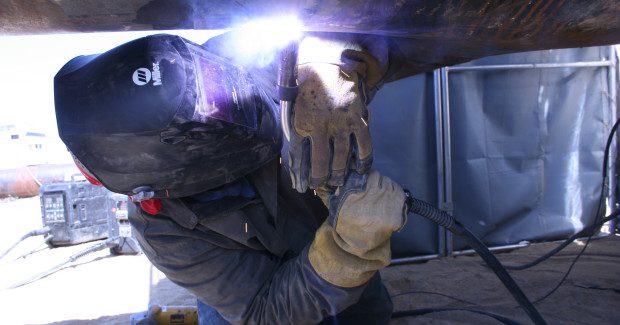New Ways for a New Day
Advances in welding technologies and processes can help fabricators address the shortage of skilled welders, shorter project turnaround times, the need to report and document weld quality, and other critical industry challenges that are impacting their profitability. Here’s how.
Posted: July 31, 2015
We’re competing in a new day, a time when operator shortages, changing regulations and materials, and shortening project timelines are impacting many fabrication shops. More than ever before, companies are looking for successful strategies that help them cope with all of these industry trends. Welding is often lost in the total project management budgeting process and can even be overlooked when operations seek ways to improve their productivity and reduce costs. Yet new welding technologies and processes are available that offer greater productivity, quality and ease of use in both shop and field applications. They provide options that can help shops meet these changing demands.
PROCESS ADVANTAGES
Because these systems are evolving, many issues and benefits must be evaluated when considering an investment in new equipment or a switch to new processes. For example, to help increase productivity and weld quality in traditional stick, TIG or MIG processes, new electrical components embedded inside welding machines have led to arc improvements in stick and TIG operations. A stable, more consistent arc is easier to manipulate to ensure good fusion and improved weld quality. Further advances in new equipment provide the ability to sense when an arc is being initiated or extinguished to allow the output to be adjusted in a way that limits the potential for tungsten inclusions at the start of the weld. It also cuts the arc off at the end of the weld while keeping the torch in place to shield the weld pool, reducing the potential for porosity.
Remote control offers numerous benefits for many welding processes, particularly in field applications, providing the ability to make process changes and parameter selections at the weld joint that significantly minimizes the downtime that operators spend traveling back and forth to the power source. This results in more arc-on time, which helps the operators complete more welds and achieve higher overall productivity. Remote control also reduces trip and fall hazards to improve operator safety.
Other advances in push-button process changeover and digital interfaces have made welding equipment more intuitive and easier to use for operators, reducing the time they spend on machine setup and changeover.
Switching to new welding processes in field applications can significantly increase productivity without sacrificing weld quality because nearly 80 percent of the costs associated with welding in the field are related to labor. Pulsed MIG and modified short-circuit MIG processes offer high weld quality and increased efficiency through travel speeds that are three to four times those of TIG or stick welding. These processes are commonly used in the fabrication shop and are now available in machines designed to meet the demands of jobsite and field applications.
These new welding processes are well-suited to many applications and industries. For example, Regulated Metal Deposition (RMD®) is a modified short-circuit MIG process that can be used for the root pass in pipe welding. It can create a thicker root pass of 3/16 in or greater — enough to eliminate the need for a hot pass in many cases and to support the heat input of pulsed MIG or flux-cored welding for the fill and cap passes.
This offers easy puddle control to help reduce operator training time and quality arc performance that boosts productivity. A modified short-circuit MIG process also produces less spatter and allows for the elimination of backing gas.
Pulsed MIG provides better fusion and fill at the toes of the weld, higher travel speeds and deposition rates, and shorter changeover time, since the same wire and gas can be used with advanced MIG processes.
BUSINESS ADVANTAGES
These sorts of welding investments can help shops reduce rework due to quality issues, significantly improve productivity to better meet tight project timelines, and address safety concerns by reducing trips to the power source to adjust weld parameters. The new technologies designed for use in the field can provide the same quality arc performance and results that operators see in the shop, making it easier and faster to produce code-quality welds on the jobsite.
The processes also are easy to use, so operators can be trained and on the job faster, helping fabricators expand their skilled labor pool in less time – all of which can impact the bottom line and differentiate a welding operation so it can remain competitive in a time of economic and industry changes.
Being open to new operations like these can help a shop proactively manage industry changes and reap productivity and quality benefits, but when considering a new welding technology and process, it’s important to work with contractors or internal departments to outline a testing plan that ensures quality and productivity goals are achieved. Welding equipment and consumable suppliers can also be helpful in the process of considering such an investment.
These advancements can help fabricators address the shortage of skilled welders, shorter project turnaround times, the need to report and document weld quality, and other critical industry challenges.

















